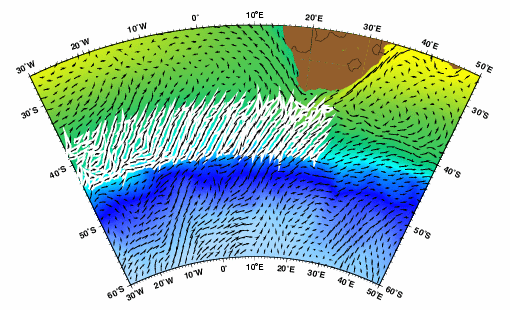
| ||
| The South Atlantic current as represented by the Mariano Global Surface Velocity Analysis (MGSVA). This current, with the Antarctic Circumpolar Current, is also known as the West Wind Drift. It feeds the Benguela Current, the Algulhas retroflection current, and the South Indian Current. Click here for example plots of seasonal averages. | ||
Data sparcity, eddy variability, weaker flow than its Gulf Stream-fueled counterpart in the north Atlantic (Thomson, 1971), and that between 30° to 60°S, the South Atlantic is under the influence of strong northwesterly winds that drive a broad eastward drift, makes it difficult to distinguish between the southern boundary of the subtropical gyre and the northern boundary of Antarctic Circumpolar Current.
The hydrographic boundary between the south Atlantic subtropical gyre and the Antarctic Circumpolar Current has been long known as the subtropical convergence (Deacon, 1933) a feature that Krummel (1882) had already described as being a sharp temperature discontinuity streching across most of the south Atlantic. According to Deacon (1933), the convergence "is marked by a sudden change of surface temperature of at least 4°C, and a change of salinity of at least 0.5". In a more comprehensive study Deacon (1937) described the variation of temperature and salinity during summer and winter months.
Maximum Ekman convergence due to wind, occurs, on the average, near 40°S in the south Atlantic Ocean. Deacon's use of the term subtropical convergence has been widely used for more than half a century, but recently the term SubTropical Front (STF) has come into use for the subtropical gyre-Antarctic Circumpolar Current boundary (Hofmann 1985; Whitworth and Nowlin 1987). In the South Atlantic, the subtropical front can be traced from 40°S offshore of the east coast of South America into the Indian Ocean. The term SubAntarctic Front (SAF) is also used for this boundary in the western south Atlantic, but the SAF is in general thought of as being the northernmost front within the Antarctic Circumpolar Current system. The surface current associated with the STF is not particularly strong when compared with, for example, those associated with the fronts within the Antarctic Circumpolar Current. The large surface temperature and salinity gradients at the STF tend to compensate each other in terms of density as warm, saline water lies to the north of cooler, fresher water (Roden, 1986).
Based on the 34.9 isohaline, the STF between 35° and 25°W tends to be south of 40°S while it is primarily north of that latitude between 25°W and 10°E (Stramma and Peterson, 1990). However, at 10° and 20°W, the STF in the temperature field is just south of 40°S (Lutjeharms, 1985). Deacon (1937) noted fluctuations of 6 degrees of latitude or more are common due to seasonal variations. Surface speeds associated with the STF is on the order of 20 cm s-1 relative to 1500 db in the Argentine basin (Roden 1986), while at the Greenwich meridian a surface velocity of 13 cm s-1 relative to the bottom was observed (Whitworth and Nowlin, 1987). At depths of 800-1000 m, the SAC is still recognizable as a current core. In the south-western Atlantic, the SAC has an average volume transport of about 30 Sv in the upper 1000 m with maximum transport values as high as 37 Sv (Stramma and Peterson, 1990). The transport of the SAC diminishes to less than 15 Sv in the vicinity of southern Africa, where it turns northward to feed the Benguela Current. Trajectories of surface drifters during the first Global Atmospheric Research Program reflect not only geostrophic flow but Ekman and Stokes contribution as well (Peterson, 1985), average surface speeds near the STF are about 20 - 26 cm s-1 (Hofmann, 1985).